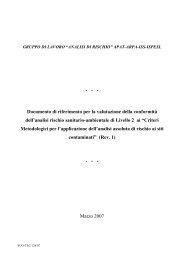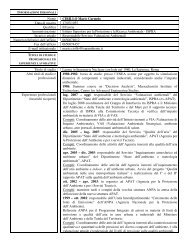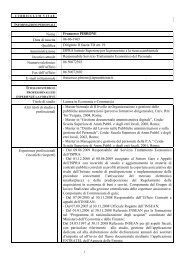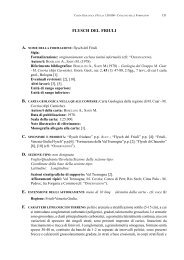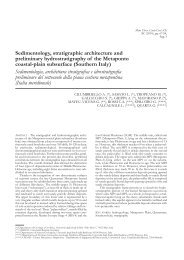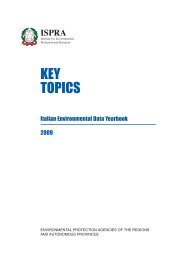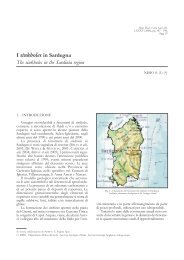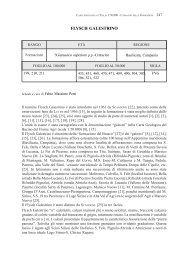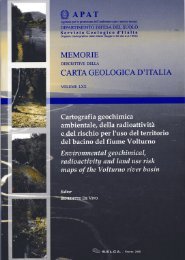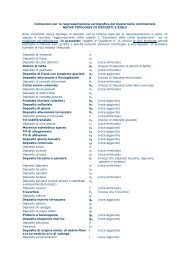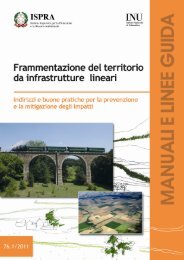Guidebook - Ispra
Guidebook - Ispra
Guidebook - Ispra
Create successful ePaper yourself
Turn your PDF publications into a flip-book with our unique Google optimized e-Paper software.
Volume n° 1 - from PR01 to B15<br />
B12<br />
B12 -<br />
Leader: M. Sandulescu<br />
marbles with ubiquitous leucogranite injections;<br />
the entire sequence is strongly sheared, with a steep<br />
foliation and EW - trending horizontal lineation. Manolescu<br />
(1937), Pavelescu et al., (1964) and Berza et<br />
al., (1983) ascribe this carbonatic-graphitic sequence<br />
to the Lainici-Păiuș Group, while Savu et al., (1984)<br />
consider it as part of the Drăgșan Group (T. Berza, in:<br />
Berza et al., 1994).<br />
Stop 6.5:<br />
Km 111. Lainici-Păiuș Group in the<br />
Lainici Nappe.<br />
Downriver to km 106 (Lainici Monastery), the Jiu<br />
Gorges are carved into the Lainici-Păiuș Group,<br />
exposing its Quartzitic Formation (an alternance of<br />
various quartzites, biotite gneisses and mica-gneisses).<br />
Leucogranitic injections and various migmatites<br />
are widespread. The general aspect of the rocks is<br />
mylonitic, with a pervasive north-dipping mylonitic<br />
foliation and retrograde greenschist facies recrystallization.<br />
Several porphyritic dykes are emplaced in this<br />
sequence. Relict mineral assemblages of an early high<br />
T-low P metamorphism (Precambrian) are preserved<br />
in places (andesine, garnet, sillimanite, andalusite,<br />
cordierite, hornblende), strongly overprinted by later<br />
greenschist retrogression (albite, chlorite, tremolite,<br />
epidote, stilpnomelane) (T. Berza, in: Berza et al.,<br />
1994).<br />
Stop 6.6:<br />
Km 105. Rafaila - Lainici-Păiuș gneisses<br />
and Schela Formation.<br />
At the Rafaila Cross, the left bank of the Jiu shows<br />
mostly Quaternary deposits at the mouth of a lefthand<br />
tributary, with huge blocks of sandstones and<br />
conglomerates and smaller debris of pyrophyllitechloritoid<br />
slates (famous occurrence of chloritoid).<br />
The Liassic age is well documented by plant remains<br />
further west. The Schela Formation is overthrust<br />
southwards by the Lainici-Păiuș Formation (Lainici<br />
Nappe). On the next 500 m of the road, rocks of the<br />
Lainici - Păiuș Group are exposed: quartzites ± plagioclase<br />
± biotite ± muscovite ± garnet ± diopside<br />
alternate with mica gneisses ± sillimanite. The latter<br />
may reach 2 cm in length and show a strong horizontal<br />
EW-trending lineation. Dikes of porphyritic microdiorites<br />
show a pervasive Alpine mylonitization.<br />
The first outcrops of Șușiţa granitoids begin at km<br />
103.700, the rocks being foliated and altered, being<br />
transformed into quartz-albite-K feldspar-muscovite-<br />
chlorite-stilpnomelane-epidote mylonites.<br />
Down to the Runc brook, the granitoids have been affected<br />
by a Hercynian schistosity. They are laminated<br />
and transformed into sericite-chlorite “orthoschists”;<br />
the K feldspar megacrysts resist better to the deformation<br />
processes (T. Berza, in: Berza et al., 1994).<br />
Stop 6.7:<br />
Km 97. Șușiţa granitoids.<br />
The Șușiţa pluton consists of biotite granites and<br />
biotite- hornblende granodiorites and tonalites. The<br />
texture is more or less massive. It is the longest pluton<br />
of the South Carpathians (50 km in length).<br />
After leaving the Jiu Gorges the fieldtrip proceeds<br />
across the Neogene formations of the Getic Piedmont.<br />
Stop 6.8:<br />
Tismana monastery. Tismana granite.<br />
The porphyritic coarse-grained Tismana granites consist<br />
of microcline, plagioclase (An 30), quartz, biotite<br />
and accessories. The K-feldspar megacrysts reach<br />
lengths of 10 cm; the plagioclases do not exceed 1<br />
cm. Equigranular granodiorites also crop out in the<br />
vicinity of the hydroelectric adit. A subhorizontal<br />
metric vein of aplitic rocks crosses the granitoids.<br />
Associated in the same magmatic suite meladiorites<br />
are exposed, upriver consisting of clinopyroxene,<br />
brown hornblende, biotite, plagioclase (An 40-50),<br />
interstitial quartz, apatite. The fabric is massive.<br />
Static retrograde mineral alterations include formation<br />
of chlorite, prehnite, epidote.<br />
The Mesozoic cover consists of Liassic conglomerates<br />
and arkosic sandstones (T. Berza, in: Berza et<br />
al., 1994).<br />
The church of the Tismana monastery was built<br />
in the XIV th century; its other buildings date from a<br />
much later period.<br />
Stop 6.9:<br />
Brebina valley at Bratilovu, km 48 along the Baia<br />
de Aramă - Băile Herculane road. Getic Nappe<br />
overlying the Danubian.<br />
Between Brebina and Titerlești, the road crosses the<br />
uppermost term of the Lower Danubian cover, namely<br />
a Upper Cretaceous Wildflysch formation, consisting<br />
of a highly broken sequence of turbidites showing<br />
a block-in-a-sheared matrix texture. The olistoliths<br />
include Mesozoic rocks, basalts, serpentinites and<br />
crystalline schists, while the matrix consists of siltites<br />
and argillaceous shales.<br />
The deformational history includes tectonic shearing



